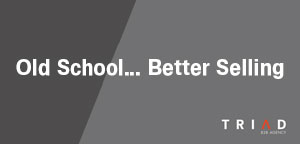
Old School… Better Selling
Old School... Better Selling

Over the past 10 – 20 years, anyone who has been involved in selling into B2B markets has been inundated with information on how one can (or should) sell using the latest technology. Emails, letters, texts, social media messaging, etc. have been promoted as the “sales tools of the future.”
This past Thursday and Friday, while attending our client’s (Portfolio Reinsurance) annual sales meeting, I was reminded how critical “old school” selling is and how the latest techniques can only supplement the proven “old school” way of acquiring a customer.
This sales meeting was primarily run by two experts in the area of automotive dealership F&I (finance and insurance) operations, Greg Hoffman and Graye Wolfe. Greg and Graye are both Managing Directors of Portfolio, and each is an outstanding businessperson, having been high performers throughout their careers. These two gentlemen have a strong track record of successfully closing very high-ticket transactions, and during the meetings, both Graye and Greg emphasized that their use of “old school” selling approaches have long been a key to their success. Some of their techniques are well worth noting, and remembering:
- If selling a large-ticket item, or an ongoing business relationship, the process is personal. Whenever possible, visit with the customer or prospect in person, and have a face-to-face discussion. Email and texts, letters, and even phone conversations are great communications tools, but they will never replace the connection, and the nuanced and clear communications, that can be realized by meeting with someone in person. And remember, most prospect’s Inboxes are loaded with emails. Similarly, many of your prospects are inundated with text messages.
- When possible, fully address the points of a transaction or business relationship that might be contentious. If these elements are going to be barriers to doing business, you are doing the prospect and yourself a disservice by not getting that information on the table as soon as possible. No one enjoys discussing what might be an uncomfortable subject, but the sooner it is addressed, the better for all involved.
- At some point in the sales cycle, one must determine whether the prospect is going to become a customer…ask for the order, or the commitment. I believe that most who sell for a living, at one time or the other, have hesitated to take the actions necessary to find out whether a prospect could be (or was going to be) a customer or not. This hesitancy is probably based on a core fear that the answer is actually going to be “no.”
Now, I am not naïve enough to think that one can rely strictly on selling to successfully move their products or services over the long term. Marketing has always played a key role in the whole “making a customer” process, at times even serving to predispose the prospect towards your sales message prior to a meeting. Today, a company has many new options for marketing success – digital advertising, social media (particularly LinkedIn®), email marketing, Search Engine Marketing (including Pay-Per-Click Google ads), e-marketing/retargeting advertising, e-newsletter and website advertising, emailing, texting, etc.
However, even in the area of B2B marketing, certain “old school” techniques can be very effective, when combined with some of the new marketing techniques.
- Print advertising, creatively developed and placed in carefully selected trade publications, can often help garner attention, build a brand, and elicit a prospect response.
- Because the volume of B2B direct mail has been reduced (mostly replaced by less-expensive email), a well-concepted, written, and designed direct mailer can stand out in a manner that gets noticed.
- Carefully crafted letters, professionally produced, can also get attention that an email cannot.
So, while anyone who is selling or marketing into the B2B space should be conversant in all of the new marketing and sales tools at their disposal, one should not forget the many proven “old school” techniques. Using these techniques in conjunction with modern marketing and sales tools, can add to the effectiveness and efficiency of your overall sales and marketing efforts.

